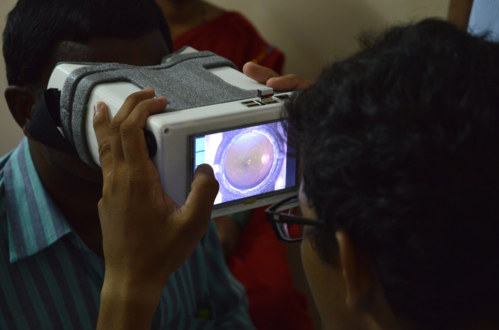Medical grade equipments are usually very expensive, partly because of their complexity, but also because of certifications, legal reasons, and low manufacturing volumes. That’s where open source hardware can make a big difference, and there has been several open source hardware prosthetic hands or arms such as Openbionics hand, but Ebin Philip and his team has tackled another issue with Project OWL, an open indirect ophthalmoscope (OIO) designed for screening retinal diseases, which normally costs between $10,000 to $25,000, but their open source hardware design can be put together for about $400.

The design features a Raspberry Pi 2 board connected to a WaveShare 5″ Touchscreen LCD, a Raspberry Pi Pi IR Camera (M12 lens mount) with 16mm FL M12 lens, a 3 Watt Luxeon LED, two 50x50mm mirrors, a linear polarizer sheet, a 20 Dioptre disposable lens, and various passive components.

While the Raspberry Pi board is not open source hardware itself, Ebin has shared the CAD files for the design, as well as the schematics and gerber files for the RPi shield used in the project on Hackaday.io, where you’ll also find some details about the project log. Assembly instructions are currently missing however. One of the software side, the image are processed through OpenCV to remove background image and reflections.
The main goal of the project is to detect retina problems on diabetic patients in rural areas:
Currently there are over 422 million people worldwide suffering from diabetes. 28.5% of them suffer from Diabetic Retinopathy. 50% of diabetics are unaware about the risk of losing their vision. The number of cases of diabetic retinopathy increased from 4 million in 2000 to 7.69 million in 2010 in US alone. Early detection and Treatment can help prevent loss of vision in most cases.
Detection of Diabetic Retinopathy, requires expensive devices for Retinal Imaging , even the cheapest of them costing more than $9000 each. This makes good quality eyecare, expensive and inaccessible to the less privileged. The key idea in the development of OIO (code-named Project OWL) is to provide an affordable solution to help identify DR and hence prevent cases of “avoidable blindness”.
I’m unclear whether this tool is also appropriate for other tests such as dilated fundus examination, or to check the optical nerves for glaucoma patients, etc…. But if it can be used or adapted for such purposes the implications would even better greater.

Jean-Luc started CNX Software in 2010 as a part-time endeavor, before quitting his job as a software engineering manager, and starting to write daily news, and reviews full time later in 2011.
Support CNX Software! Donate via cryptocurrencies, become a Patron on Patreon, or purchase goods on Amazon or Aliexpress





I just want my ophthalmologist to have it. Every-time some geezer complains about vision lose the doctor can’t see with the normal test, they get refereed to this. So, you end up needing to schedule the test two month in advance since waiting list is so long… And for what? A 10 seconds exam where the nurse takes a picture of your eye…
Oh, and I asked the doctor at the time, and he said that if he had one, he could skip most of the eye-drops expanded pupils tests (dilated fundus)… It was just his opinion, but it sounds pretty clear to me…
I’m an eye doctor, and let me tell you, they should expect a killing squad.
I’m an eye doctor as well. Many of these problems could be vastly reduced by insurance companies paying doctors for their time to perform annual exams, and streamlining the process rather than continue the mess we have today in the US. We could make it easier for doctors and for providers. There is an overabundance of eye doctors in the US, so we don’t really need unqualified people to operate more equipment.
And beyond that, education is key. Patients often can not grasp, or will not admit to themselves, that retinopathy can occur even in patients with mild forms of diabetes.
If you have diabetes, get an annual dilated eye examination. End of story. Realize “ruining” three hours of your life because of dilation (the hate is unrational) may actually allow you to see for an additional four decades. I’ve seen patients in their 30s permanently lose vision after repeated attempts to educate them on the importance of proper blood sugar regulation, proper diet and exercise, etc. I’ve also lost friends to diabetes (in their 30s as well).
And, in reality, dilation is not really that bad at all. Let us all get over it. And finally, it can detect many, many other unsymptomatic eye diseases as well, not just those caused by diabetes.
That said, technology is cool. I’m just not sure how a retinal photograph can detect iris neovascularization or many of the other signs of diabetic eye disease.
Tell your friends and family with diabetes to take it seriously. And remind them their eyes are living tissue and connected to their bodies.
Google also uses machine learning technology to help detect Diabetic retinopathy -> https://blog.google/topics/machine-learning/detecting-diabetic-eye-disease-machine-learning/